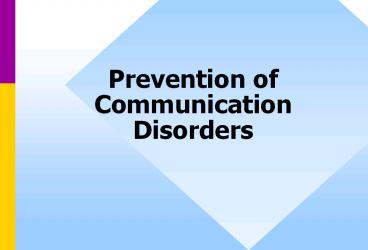Prevention of Communication Disorders - PowerPoint PPT Presentation
Title:
Prevention of Communication Disorders
Description:
Title: Prevention of Communication Disorders Author: M.I.S. Last modified by: Created Date: 4/30/1998 5:24:58 PM Document presentation format – PowerPoint PPT presentation
Number of Views:78
Avg rating:3.0/5.0
Title: Prevention of Communication Disorders
1
Prevention of Communication Disorders
2
ASHAs Prevention Curriculum Guide for
Audiologists and Speech-Language Pathologists
3
Why is Prevention Important to the Audiologist
and Speech-Language Pathologist?
4
Foundations of Prevention
- Prevention
- Inhibiting or interrupting the progression of
disease, disorder, or disability - Health Promotion/Wellness
- The combination of educational and environmental
supports for actions and conditions of living
conducive to health
5
The Professional Role of the Speech-Language
Pathologist and Audiologist
- Competencies and Responsibilities
- Prevention Activities
- Assisting with National Initiatives
- Healthy People 2000 2010 Objectives
6
Levels of Prevention
- Primary Prevention
- Secondary Prevention
- Tertiary Prevention
7
Primary Prevention
- Health Education
- Genetic Counselling
- Environmental Change
- Hearing Conservation
- Immunization
- Prenatal Care
- Vocal Hygiene
- Prevention of Secondary Communication Disorders
8
Secondary Prevention
- Screenings
- Speech-Language Disorders
- Hearing/Balance Disorders
- Early Intervention
- Hearing/Balance Disorders
- Speech-Language-Swallowing Disorders
9
Tertiary Prevention
- Treatment of identified disabilities
- Family/caregiver education programs
- Patient counseling
- Cross-disciplinary consultation
10
Prevention Science
- Epidemiology
- Data
- Risk
- Incidence and prevalence
- Relative risk and odds ratio
- Population attributable risk ratio
11
Models of Health Behavior and Health Education
- Individual Health Behavior Models
- Group Intervention Models
- Applying Health Education Models to Communication
Disorders
12
Genetic Influences
- Genetics Disorders
- Preventive Approaches
13
Environmental Influences
- Physical
- Toxins
- Nutrition
- Sick buildings
- Noise pollution
- Second-hand smoke
- Lead
- Social
- Violence
- Substance abuse
- Child rearing practices
- Poverty
14
Multicultural Influences
- Culture
- Influences on health, social, and educational
behaviors and practices - Planning Prevention Targets
15
Prevention Across the Life Span (Specific
Disorders)
- Dysphagia
- Literacy and Learning Problems
- Oral Problems/Cancer
- Ototoxicity/Noice-Induced Hearing Loss
- Stroke
- Stuttering
- Traumatic Brain Injury
- Voice Disorders
16
Prevention Across the Life Span(Distinct Age
Categories)
- Prenatal/Antenatal
- Infancy
- Early Childhood
- School-Age
- Adulthood
- Maturity
17
Models of Prevention Program Design
- Public Health PRECEDE-PROCEED
- Comprehensive Health Education Model (CHEM)
18
Prevention Program Objectives and Initiatives
- Program Objectives
- Stating Prevention Outcomes
- Implementing the Prevention Program
19
Determining the Success of Prevention Efforts
20
Public Policy and Public Health
- ASHA Public Policy Agenda for Prevention
- Public Health and Professions of Speech-Language
Pathology and Audiology
Review this Lecture































